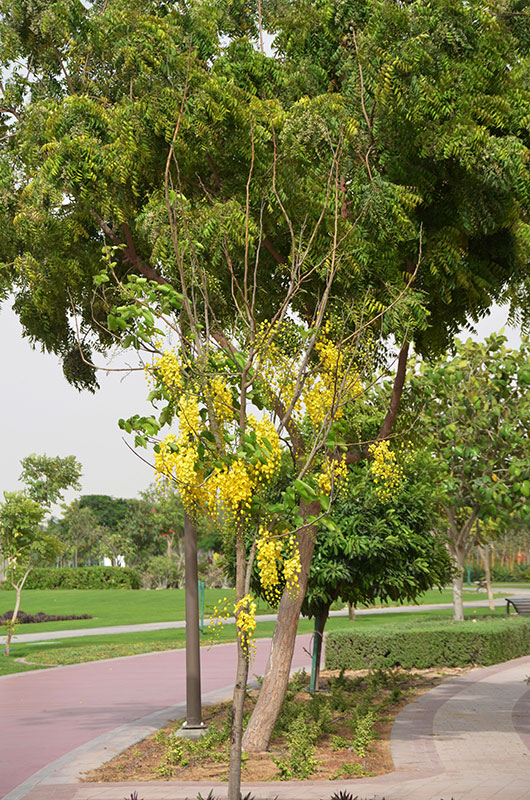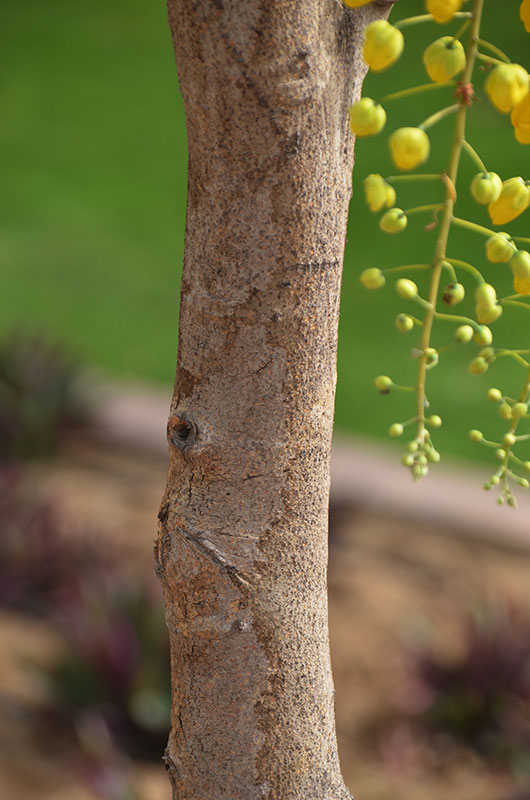| General Description | Cassia fistula is a flowering tree in the Fabaceae family native to India and Southeast Asia. It is a showy plant with vibrant flowers in the spring and early summer. |
| ID Characteristic | Medium to large-sized tree with an oval to rounded shape. Distinctive yellow flowers in the spring persisting into the summer which mature into long brown cylindrical legumes that persist into the following spring. |
| Shape | This tree has a rounded and somewhat irregular shape. |
| Landscape | Cassia fistula has high ornamental value in tropical areas where it can be used as a specimen, accent, or street planting. Suitable in areas of drought or saline soils and where pollution may be an issue. |
| Propagation | Care must be taken when handling seeds as they are poisonous. The seeds must be gathered from pods and cleaned thoroughly to remove the pulp. Once cleaned, seeds must be gently scarified and soaked for 24 hours prior to sowing. Seeds can then be planted in well-drained soil in a warm sunny location and watered infrequently. In 1 - 4 weeks, the seedlings will emerge. |
| Cultivation | Grown in subtropical and tropical regions, it does best in full sun and well-drained soil. It is drought and salt tolerant, however, it will suffer if exposed to freezing weather, even briefly. |
| Pests | Cassia fistula is susceptible to mildew, leaf spot, and root diseases. |
| Notable Specimens | University of Arizona, Nugent Building, Arizona, United States of America. Royal Park Rajapruek, Mae Hia, Thailand.
|
| Habitat | Grows in valleys of India and the Himalaya region up to approximately 1200 m. Common in deciduous forests in the region. |
| Bark/Stem Description | The bark is smooth to slightly ridged, grey when young, and changing slightly to a darker grey-brown when mature. |
| Leaf Description | Pinnately, compound, opposite leaves that are smooth and ovate-shaped, with 6 -16 leaflets. The leaf can range from 15 - 60 cm long, with each leaflet ranging from 7 - 20 cm long. The leaves will fall periodically, only to be replaced with new foliage. However, complete leaf drop occurs during the flowering period in March. |
| Flower Description | Large bright yellow flowers grow from pendulous 40 cm racemes. Each flower has five equal-sized petals, and is about 2 - 4 cm in size. |
| Fruit Description | Ranging from 30 - 60 cm long and up to 3 cm wide. The terete is glabrous, indehiscent pod is black at maturity. It has a strange pungent smell. While the fruit pulp has medicinal properties, the seeds are poisonous. The pods contain approximately 30 -100 large hard flat, round seeds.
|
| Colour Description | Cassia fistula tree is well known for its impressive yellow flowers that cover the entire canopy. The flowers mature into brown to purple-black pods. The leaves on this tree are green year round, and remain green until they fall off and are replaced. The bark of the tree is grey-coloured when young, which changes to a darker grey-brown colour as it ages. Flower buds are green when immature. |
| Texture Description | Medium texture and very fine flowers. However, the tree has a rather rough-textured bark and plain leaves. |


